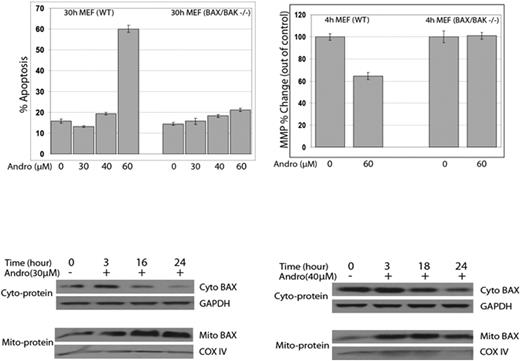Abstract
Abstract 2710
Poster Board II-686
Andrographolide is a diterpenoid lactone isolated from Andrographis paniculata (King of Bitters), an important herbal medicine used in China and other Asian countries to treat a range of diseases, such as respiratory infection, fever, bacterial dysentery and diarrhea. The major bioactive component extracted from Andrographis paniculata is andrographolide. The three hydroxyls at C-3, C-19 and C-14 are responsible for its biological activities. Recently, the anti-cancer properties of andrographolide have been recognized, and it has been tested in human patients. We hypothesized that the mechanism of cell death may depend on caspase activation and mitochondrial mediated cell death pathways.
Using cells lines Ramos (p53 mutated Burkitts lymphoma (BL)), HF-1 (follicular lymphoma (FL)), SUDHL-4 (diffuse large B-cell lymphoma (DLBCL)) and Granta (mantle cell lymphoma (MCL)) we measured cellular cytotoxicity by MTT and apoptosis and quantified by Annexin V-FITC and PI with flow cytometry using FACS. Reactive oxygen species (ROS) production was determined by oxidation of H2DCFDA to dichlorofluorescein (DCF) and quantified by fluorescence intensity and read by flow cytometry. We investigated the mechanism of apoptosis in lymphoma cell lines and patient samples by measuring caspase activation and PARP cleavage by Western blot and Bax conformational change by immunoflourescence. Further, we dissected the influence of the Bax/Bak pathway by using Bax−/−/Bak−/− mouse endothelial fibroblasts (MEFS).
We found that andrographolide inhibited survival in all cell lines and was dose and time dependent (IC50 from 15-40uM in cell lines), and was accompanied by ROS production. Cell death was a result of apoptosis and was also dose and time dependent and inhibited by the anti- oxidant N-acetyl-L-cysteine (NAC) and by the pan-caspase inhibitor Z-VAD-FMK and enhanced by the glutathione (GSH) depleting agent buthionine sulfoximine (BSO) and accompanied by PARP cleavage. Similar data were extant in fresh samples from patients with FL, DLBCL, and MCL and there was activation of caspases 3, 8 and 9 in all cell lines and in all patient samples. In order to determine if mitochondrial pathways are involved in cell death, we studied Bax conformational change with the 6A7 monoclonal antibody, which specifically binds Bax protein with conformational change. We found that andrographolide induced Bax conformational change in SUDHL4 and HF1 and similarly in diffuse large B-cell lymphoma and follicular lymphoma pt samples and that this was accompanied by translocation of Bax to the mitochondria in SUDHL-4 (Figure bottom left) and HF-1 (Figure bottom right). Next, using mouse endothelial fibroblast (MEFs) Bax/Bak knockouts (MEFBAX−/−/BAK−/−), we found that andrographolide-induced apoptosis (Figure top left) and change in mitochondrial membrane potential (Figure top right) was mediated through Bax/Bak.
This is the first demonstration that andrographolide causes ROS-dependent apoptosis in lymphoma cell lines and in primary tumor samples, and the mechanism appears to proceed through intrinsic and extrinsic caspase pathways and is associated with Bax/Bak mitochondrial translocation. Further studies of diterpenoid lactones in lymphoma are warranted.
Gordon:Cure Tech: Membership on an entity's Board of Directors or advisory committees.
Author notes
Asterisk with author names denotes non-ASH members.


This feature is available to Subscribers Only
Sign In or Create an Account Close Modal